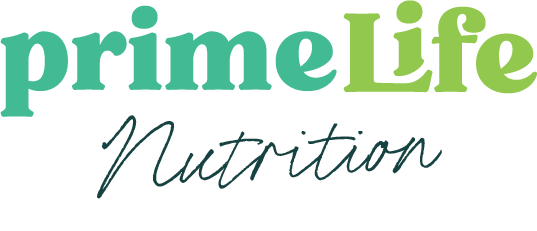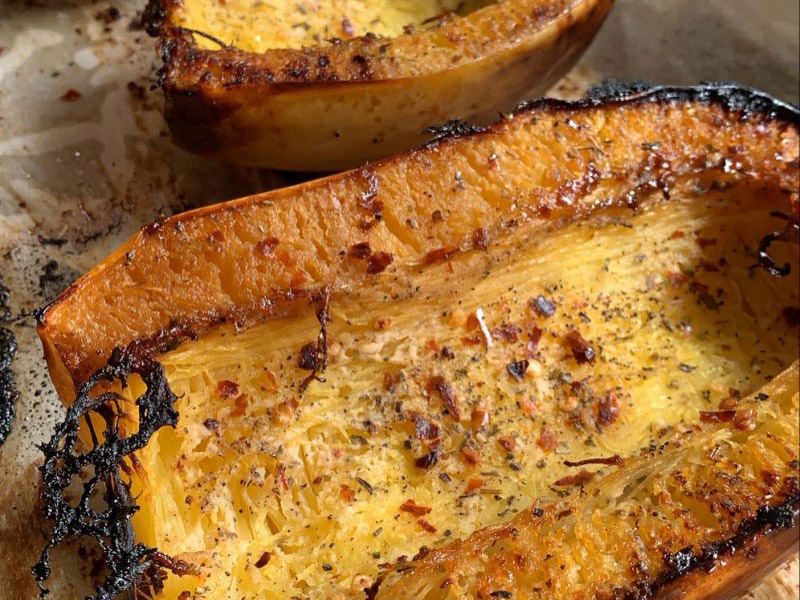
by Primelife Admin | Dec 21, 2020 | Recipes
- 1 spaghetti squash
- 3 tbsp olive oil
- Salt and pepper
- Garlic powder
- Onion powder
- Italian seasoning
- Red pepper flakes
- 1/2 onion, chopped
- 1 lb ground beef
- 2 lbs hot italian sausage (or sausage of choice)
- 1 cup tomato sauce
- 1 jar diced tomatoes
Preheat oven to 400 degrees.
Stab the squash with a fork or knife all around to poke holes in the flesh.
Microwave for about 5 minutes..it will be hot, use oven mitts to remove it.
Slice the stem off the squash, then slice in the half lengthwise.
Scoop out the seeds with a spoon.
Brush with 2 tbsp olive oil and sprinkle with your favorite seasonings (I used s&p, garlic powder, onion powder, red pepper flakes, Italian seasoning).
Place squash side down on a lined cookie sheet and bake for 1 hour.
While that’s cooking, set your pressure cooker on the sauté setting.
Add 1/2 onion chopped and drizzle 1 tbsp olive oil to sauté.
Add 1lb ground beef (I used wagyu), and 2lbs ground sausage (I used hot Italian) mix to combine until cooked through and cancel the sauté function.
Add 1 cup (1/2 jar) of tomato sauce and 1 can diced tomatoes.
Cover and cook for 35 minutes. Once everything is done, plate it up and devour!
For a crockpot version, make the squash as directed. Sauté the onion and meat in a pan, throw in the crockpot. Add the tomato sauce and diced tomatoes and cook on high for 3 hours.

by Primelife Admin | Dec 21, 2020 | Featured, Food Science, News
When you head to the grocery store, do you go with a plan, a list, or an agenda? This can help keep you on track, but most grocery stores are counting on you browsing and buying more than you need. They have many methods in place that persuade you to add extra items to your cart that you didn’t plan on buying. Before you know it, a trip that should’ve cost about $130 ends up costing closer to $250-300! Sounds like Target trips, am I right? Check out the top ten tricks the grocery store puts in place to get you to buy more than you need.
- The Atmosphere
Grocery stores want you to walk into a bright and inviting store. This is why the produce is front and center when you enter. It’s colorful, bright, and boosts your mood. You’ll often see the floral department or bouquets of flowers in the front entrance as well. How do flowers not brighten your mood? Another quick trick is one you hear and not visualize. The music they play in the store is made to be upbeat and make you feel good. If we know anything, we know that when we’re in a good mood, we’ll end up buying more.
- Layout of the store
Ever heard the advice to stick to the perimeter of the store for healthy foods? Well, this is also where the higher ticket items are. Fresh produce, meats, fresh dairy, and seafood are all on the perimeter of the store and ironically the more expensive items as well. They also strategically have the bathrooms and staple foods items like bread, milk and eggs in the back of the store so you’ll walk through the whole store to get to them. They’re counting on you adding more items to your cart while walking to the back of the store.
- Reducing the price by a penny
If you look at something that’s $4.00 versus something that’s $3.99, you perceive the $3.99 item to be cheaper. It’s been researched many times that lowering the price by just a penny persuades customers to buy it. Although we know that it’s a $4 item, we’re more likely to buy it seeing the 3 in front of it rather than the 4.
- Giving percentages off rather than dollars
Using percentages off makes an item seem like more of a deal rather than giving a certain dollar amount off. If a steak is $20, most stores will advertise that it’s 20% off rather than giving $5 off. Twenty percent off is only $4 off the purchase price, even though the number of the discount is higher. So although it seems like a better deal, it may not be as great as you think!
- Buzzwords
They work everytime! Putting certain words on packages automatically makes us perceive it as healthy. Seeing “gluten free”, “all natural”, “high protein”, “keto”, “paleo”, “low fat” are just a few of the buzzwords that we see on foods. These don’t necessarily make foods a healthy option, but what they will do is increase the price. You’ll end up spending more on something that you may not have needed, but because it looks healthier, you just have to try it!
- Bo-Go Items
Buy-one-get one free always seems like such a great deal. However, that food or drink is overpriced and then listed as “bo-go” to get you to buy two rather than one. Companies set the price to cover the 50% off and also make a profit. So next time you see this deal, think about whether or not you really need two and if it’s actually a good deal.
- Increasing Demand
Creating a false sense of urgency is a great way to create demand. When you see “limited time”, “limited release”, “new flavor”, “while supplies last” and “single-batch” you’re most likely to grab it because it’s new and something that may not be there the next time you come back. The stores are counting on you wanting to try the newest item or flavor so you grab it while you can.
- Product Placement
Every item that’s placed on the shelves is placed with intention. Ever notice that the store-brand items are often on the bottom, name brand is in the middle of the shelves and the highest priced items are towards the top? Consumers are more likely to grab the foods at eye level or higher, so the cost of the foods you buy are just a little bit higher than store-brand.
- Check-out line grabs
The check-out line always has candy, gum, and snacks at the ready so you can grab a pack of gum or that sweet treat you’ve been craving. These items are purposely put at arms-reach of kids in the cart so they can grab it as well. Just another way to increase your spending amount, even by a candy bar.
- Paying virtually
Credit cards and apple pay have made it SO much easier to swipe or scan and everything is paid for. This ease of payment makes the cost of the bill seem unimportant and something we don’t even think about. If you were to pay in cash and have to count it out, it makes it feel much more real. The easier it is to pay, the less we’re likely to pay attention to how much we’re spending.
Next time you hit the grocery store, make sure to have a list of items, stick to the list and try not to be persuaded by buzzwords. Of course there’s always that one thing you want to try or that grabs your attention, but now you can be more aware of some of the tactics stores are using. Moral of the story here is grab the foods that interest you, but if you’re trying to stick to a budget, beware of these strategies!
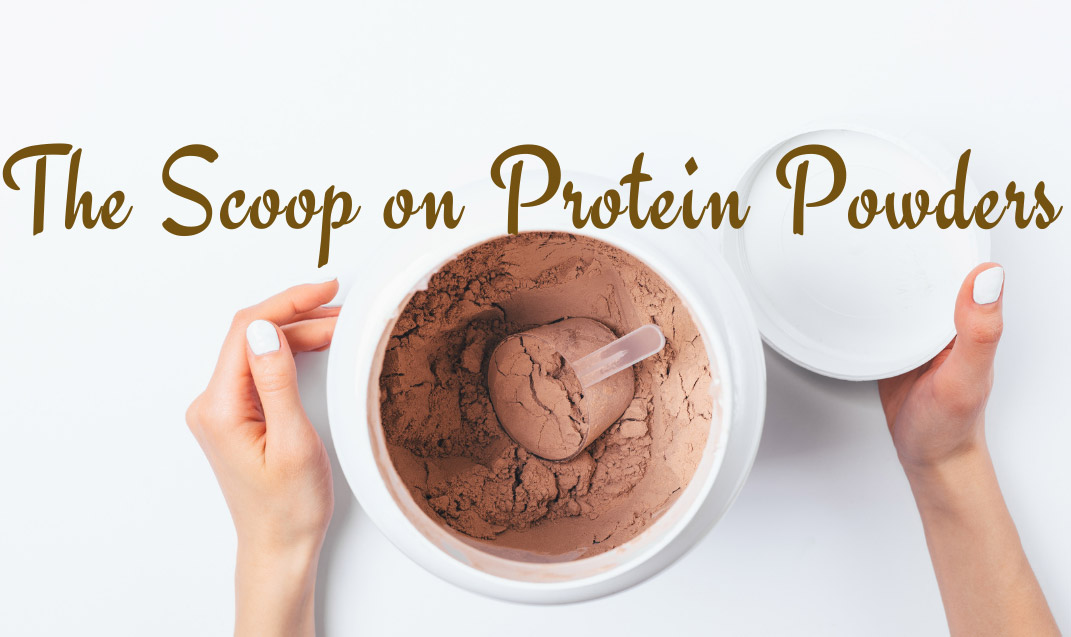
by Primelife Admin | Oct 15, 2020 | Featured, Fitness, Food Science
Protein powders are always a topic of conversation and this blog is going to help break down what they are, what types may be more beneficial for you, and if you should even be taking one. Let’s first talk about what types of protein powders are out there and why they’re different.
- Whey – One of the most common protein powders out there, and one of the first powders produced for mass consumption. It’s a complete protein (contains all essential amino acids) and helps with muscle repair and rebuilding post-workout. Whey comes from cow’s milk. It’s the whey that is skimmed off of milk when they make it into a cheese. It’s literally the whey in “curds and whey”. For this reason, some people’s digestive systems don’t take too kindly to it. If you don’t tolerate milk-based products well, this is probably not the powder for you. Whey protein isolate has the highest protein concentration and little fat content which make it desirable for muscle building without fat gain.
- Casein – This is another milk-based protein powder but is absorbed much slower and longer than whey protein. This is a great protein powder to have before bed since it will supply the body with protein overnight when you’re sleeping but your body is still recovering. Make sure to look for calcium caseinate to ensure you’re getting the purest and most absorbable form of it.
- Soy – Soy based powders are plant-based and are also a complete protein, meaning they provide all the essential amino acids your muscles need. This is a great alternative for those following a vegan/vegetarian diet or who are lactose intolerant. It is more tolerated in the gut, but those who can’t tolerate soy would want to look at alternatives.
- Brown Rice – Another plant-based protein option, but it is not considered complete. You want to make sure you pair it with other plant based protein so you do meet the essential amino acid profile your body requires. Some other protein you could pair it with include hemp or pea powder. Brown rice is also hypoallergenic and very easily digestible.
- Pea – A great protein powder that is plant-based and should be paired with other plant proteins like hemp or brown rice. It is also highly digestible and would blend well in smoothies.
- Hemp – A high-fiber plant-based protein powder that also offers up healthy fats as well. This is a great choice for a vegan or vegetarian diet, but again should be paired with one or two other plant-based proteins so you get the best protein absorption.
Dairy-based proteins like whey and casein are great choices for their muscle building benefits as well as availability of zinc and iron if you’re not vegan or suffer from allergies. However, there is a strong case for integrating plant based proteins into your diet as they are easily digestible and have been proven to fight inflammation and reduce muscle soreness more effectively than dairy proteins.
Since one plant based protein powder alone won’t offer a complete protein, look for a product that combines several to create a full amino acid profile. Some brands that offer this include Orgain, Plant Fusion or Vega One. They provide complete proteins, omega-3s, probiotics, greens, and antioxidants all in one serving.
Protein powders can be easy, affordable, and clean; you just need to know how to pick them. Start with figuring out what protein powder would be the best for YOUR body. One powder that works for someone else won’t necessarily work for you as well. Then figure out where it fits in your schedule. It could be easier to throw it in your morning smoothie, having it with milk or water right after a workout, or right before bed if you’re taking casein. It isn’t always about paying the highest price for a powder, it’s more about what your body likes most, and keeping the ingredients clean. Watch out for ingredients like corn syrup solids, brown rice syrup, hydrogenated oils, or hidden sugars like dextrose, glucose, or palm sugar. You still want to be able to recognize and understand what the ingredients are regardless of how much protein and fiber is in a supplement.
If you’re ever unsure about what protein powder works for you, you should always talk to a professional about it. The best way to figure out which one works best for you is to try it. Head to a local supplement store and try to get samples of products before you invest and buy one. If you’re going to spend the money, you want to make sure it’s the right product for you. As always, if you have any questions, feel free to reach out to us!
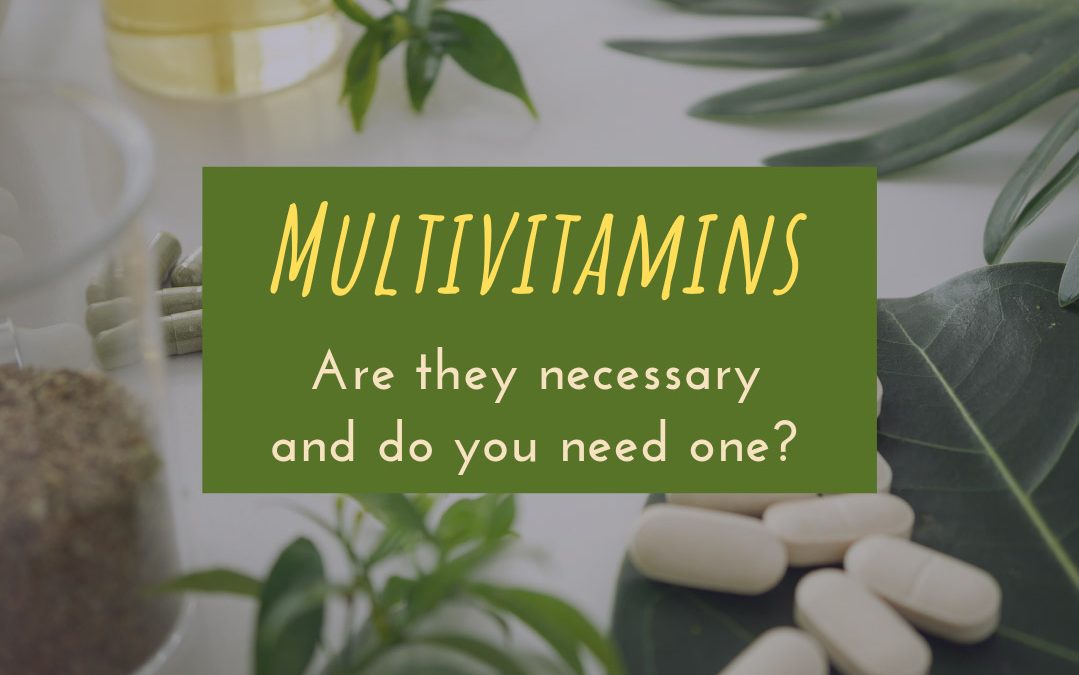
by Primelife Admin | Oct 15, 2020 | Featured, Food Science, Meal Prep
Should you be taking a multivitamin?
Before you can answer this question, you need to first take a look at your diet and any health conditions you are currently experiencing.
- Are you eating a well-rounded diet? Have you cut out any food groups?
It is important to first get your vitamins and minerals from the foods you eat. You will get more nutrition from the diversity of the foods and more fiber, phytochemicals, and antioxidants that you cannot get from supplementation. These elements of whole foods prevent diseases and improve bowel movements. However, no one person’s diet is perfect. Many people cut out certain food groups, such as dairy, for health reasons. If this is true for you, a multivitamin may be beneficial to fill in the gaps.
- Do you have a health condition that may cause you to not be able to absorb certain nutrients, or cause you to need more of a certain nutrient?
Many digestive complications such as Crohn’s disease and Inflammatory Bowel Disease can lead to malabsorption of certain nutrients. Over a period of time, nutrient deficiencies can develop and cause various symptoms. Talking to a dietitian and your doctor about your disease and possible nutrient deficiencies that may result can help you decide which vitamins you should be focusing on. Getting your vitamin and mineral levels checked can reveal if you need more than what a multivitamin can offer. If this is the case, you may be recommended to take individual supplements that have higher doses for what you need. In some situations, like being pregnant, you may need more of certain nutrients such as folic acid and iron. Pregnant women should take a prenatal vitamin.
You can never go wrong with talking to your dietitian and doctor about taking a multivitamin or a specific vitamin/mineral supplement. Explain your current diet and any health conditions you are experiencing. Above all, focusing on eating more foods in their whole and natural forms will always benefit you. You cannot overdose on nutrients when eating a balanced diet of fruits, vegetables, protein, dairy, and grains. However, you can reach a toxicity level from popping a higher dose of vitamins/minerals than you need.
Above all, if you are eating a balanced diet and are not experiencing any health conditions that require you to need more of certain nutrients, you may be better off saving your money and continuing to focus on your diet!
–Tara Greenwood Penn State University Dietetics Student
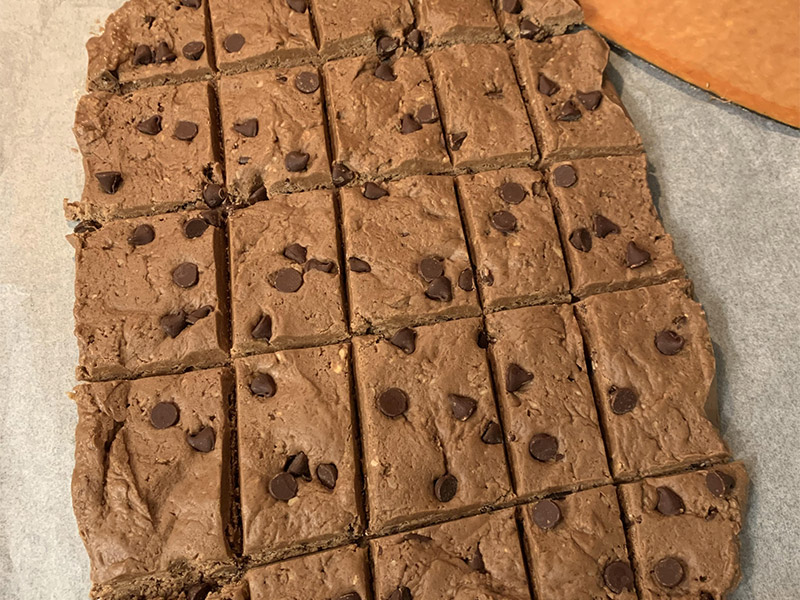
by Primelife Admin | Oct 15, 2020 | Recipes
- 1 cup oat flour (process oats in food processer until ground to a powder)
- 1 cup protein powder of choice (I used chocolate plant-based powder)
- 1 cup creamy peanut butter
- 1/2 cup honey
- 1/4 cup coconut oil, melted
- 1/4 cup semi-sweet chocolate chips (and 1-2 tbsp for topping)
- 1/2 tsp vanilla extract
Mix oat flour, protein powder, peanut butter, honey, coconut oil, and vanilla in a large bowl.
Add chocolate chips and stir to mix.
Dump cookie dough in 9×13 pan lined with parchment paper and sprinkle with remaining chocolate chips.
Press down to flatten and put in fridge for about 30 minutes.
Take out of the fridge, chop into bite-sized pieces and store in air-tight container. Throw back in the fridge to keep them fresh or store in the freezer for up to 6 months.
Enjoy bites of cookie dough for that afternoon pick-me-up or an on-the-go snack!
Adding protein powder is a great way to boost protein. Use whatever flavor you have. You could also use 2c oat flour if you don’t want to use a protein powder. Get creative and use different toppings as you see fit!
Recipe adapted from: https://www.mealswithmaggie.com/no-bake-cookie-dough-bars/#tasty-recipes-3743


